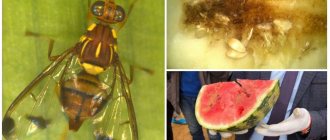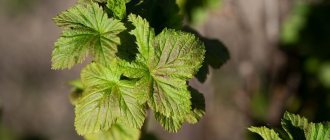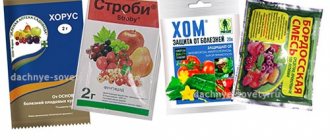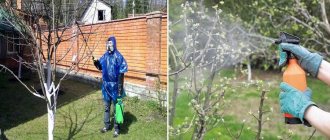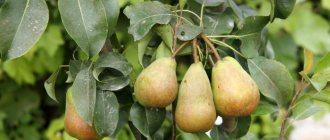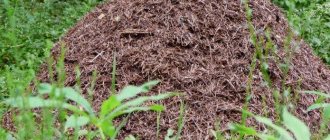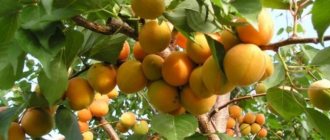Currants will delight the gardener with high yields if they are properly and regularly cared for. Treating berry bushes in the spring against pests and diseases helps minimize the risk of infection, which means it will be healthy. There are many methods and means for processing currants; they differ in the principle of action and in terms of use, but they give a good long-term effect.
Processing schedules and times
To protect currants with maximum efficiency, you need to choose the right preparations for treatment. In addition, it is necessary to observe the timing of processing garden crops, and also carry it out periodically, and not occasionally.
The plant is treated according to the following schedule:
- in early spring, when the buds are still dormant;
- when inflorescences appear;
- after flowering ends;
- when the berries are picked.
Spring treatment
The first treatment of currants in the spring is the most crucial moment in protecting the plant. After all, early spraying will destroy parasites and pathogens that have not yet awakened and have successfully overwintered under the bark and in the ground.
The buds affected by the bud mite are enlarged and rounded (shoot on the right)
Carry out spring treatment according to the following scheme:
- Carry out the first spraying in early March. Treat the bushes with 1% Bordeaux mixture or 5% solution of iron sulfate against septoria, anthracnose and rust. Cut out the tops of the shoots on which you notice a gray felt coating - this is the mycelium of overwintered powdery mildew. Remove shoots damaged by bud mites. They are very easy to identify - the affected kidneys are enlarged and round.
- Carry out the second spraying at the end of May - early June, when flower buds are just beginning to form. During this period, you will destroy a huge number of parasites that have begun active life. Use Actellik, Fufanon, Iskra-bio, Akarin, Fitoverm against mites, leaf sawflies and aphids.
- The third spraying is after the currants have faded. Spray the bushes with 1% Bordeaux mixture against mites, anthracnose, septoria, leaf sawflies and aphids.
Summer treatment
If in the spring the deadlines for treating the bushes were missed, then do not use chemicals. It is safer to use biological drugs - Lepidocil, Bitoxibacillin, Fitop, Trichodermin. You can use folk remedies (infusion: onion, garlic, citrus, tobacco leaves, dry marigolds; soda solution) . The use of chemicals during the fruiting period is strictly prohibited, as it can cause poisoning! Biological preparations and traditional methods of protection can be used to detect parasites and diseases throughout the growing season. A more detailed description of drugs and methods of control is in a separate chapter.
Autumn processing
When summer ends, be sure to take steps to ensure a decent harvest next year. The treatment is carried out after the harvest has been harvested and leaf fall has begun.
During autumn processing, keep in mind that after harvesting the blackcurrant, you can tear off the leaves - this will speed up the accumulation of nutrients for a successful wintering. And for red currants, you need to wait until the leaves fall off on their own.
During autumn processing it is necessary:
- Perform autumn pruning. Remove dry, damaged branches lying on the ground. Cut out branches that grow inside the bush. Cut off the dried tops of old branches, and leave no more than 6 buds of young ones.
- Spray the bushes against insects and infections. When the entire harvest has been harvested, treat the branches of the plant and the ground under the bushes with a 1% Bordeaux mixture. Bordeaux mixture is effective against all parasites and fungal infections. Against moths, aphids, powdery mildew - use Karbofos. Against powdery mildew and spotting - Fundazol. To protect against powdery mildew, septoria, rust, and spotting, use the biological preparation Fitosporin. If you don’t want to use chemicals, spray the currants with folk remedies - garlic infusion, onion infusion, dry marigold infusion, soda solution. Preparations and methods used to protect currants from insect pests and diseases will be described below.
- Collect plant debris and loosen the soil under the bushes. Spray the soil with a light pink solution of potassium permanganate, a 1% solution of Bordeaux mixture (100 g per 10 l of water) or copper sulfate (50 g per 10 l of water) to destroy parasites and fungal infections.
- Apply fertilizer. Scatter 1 tablespoon of potassium sulfate and double superphosphate under the currants, and then pour at least 1 bucket of water under each bush. You can add these preparations to a bucket of water and water the plants with the prepared solution.
How to treat currants against pests and diseases
In order to cause damage to pests, and not to yourself, when treating berry bushes, you need to follow a number of rules and regulations.
- Before spraying, remove all dry and diseased branches from the bush, clean the soil under it from fallen leaves, and loosen it.
- Treat the bush in March-April, when the buds have not yet begun to open.
- Don’t forget to spray the soil in the tree trunk circle (at a distance of 50-60 cm from the root).
- Carry out spraying in special clothing (gown, headdress, gloves and respirator).
- Choose for the procedure the morning or evening of a dry, windless day, when there is no precipitation in the forecast for the next 2-3 days.
- Dilute the selected drug strictly according to the instructions.
- During treatment and for the next 12-24 hours, remove children and pets from the area.
- Do not store the remaining diluted drug, but dispose of it according to the instructions.
Remember that a few warm sunny days are enough for currants to awaken and open their buds. Therefore, check it out as soon as possible if spring weather has already set in in your region, so as not to miss the deadline for the first treatment.
Preparation for spraying
Currant bushes must first be prepared for spraying:
- After the snow melts, before the buds open, prune all frozen and damaged branches. Pruning frozen branches up to the first swelling bud. Currant branches are dry and break easily, but still prune them with pruning shears . Burn the cut branches.
Trim the frozen currant branch to the first swelling bud
Tie the currant shoots to a stake or support. During harvest, it will be easy to pick clean and healthy berries.
Supports for currant bushes are easy to make with your own hands
Remove plant debris and last year's leaves from under the currants, because they contain a lot of pests that will wake up with the onset of warm days.
Remove all plant debris from under the currant bushes
Pouring currant bushes with boiling water
Watering a currant bush with boiling water
Treating currants in the spring against diseases and pests using boiling water is an effective, easy-to-use method. This procedure can destroy the bulk of insects. You will need an iron watering can and boiled water with a temperature of at least 70 degrees. With the arrival of spring, pour boiling water over the currant bushes; for the best effect, add potassium permanganate (potassium permanganate), iron sulfate or salt.
Preparations for treatment
The plant can be treated with both chemical and biological preparations. The use of folk remedies gives a good effect.
When carrying out treatment, keep in mind that pests give preference to different types of currants. Black currants are most often attacked by borers, moths, and mites. And on the red and white - aphids and sawfly.
Before you start processing currant bushes, find out the weather forecast for the near future. If it starts to rain after spraying, all the preparations will be washed away and there will be no result. And also try to carry out processing in calm weather. I once started processing in a strong wind (there was no other opportunity) and treated myself instead of bushes.
Chemicals
Chemicals are very effective in controlling pests and diseases. At the same time, they are toxic and can cause harm to humans and the environment. Therefore, when using chemicals, strictly follow the instructions and apply at the appropriate time.
- 1% solution of Bordeaux mixture or 1% solution of copper sulfate - used for anthracnose, septoria, rust and other spots. Spraying is carried out as soon as the first leaves appear on the bushes. You can buy Bordeaux mixture ready-made or make it yourself. To prepare, dilute 100 g of copper sulfate and 100 g of lime in 10 liters of water.
- Iskra, Inta-CM, Karbotsin - against aphids, gall midges, leaf rollers, sawflies and moths. Used when flower buds begin to form. The greatest treatment efficiency is achieved when spraying in cool weather, below 15o.
- Karbofos, Actellik - against aphids, gall midges, leaf rollers, sawflies and moths. It is also used at the beginning of the formation of flower buds, but it is most effective to carry out the treatment at an air temperature of at least 15°.
- Akarin, Iskra-bio, Aktara - against currant bud mite, aphids, thrips, scale insects. Apply when leaves bloom and inflorescences appear. The greatest processing efficiency is achieved at a temperature of 24–25°. Repeated spraying can be done after flowering and after harvesting.
- Vectra, Strobi, Topaz, Thiovit Jet, colloidal sulfur - against powdery mildew, anthracnose and septoria. Treatment is carried out immediately after flowering. Effective at temperatures of 19° and above. Repeatedly after harvesting.
Do I need to process currants in spring?
Yes, you shouldn’t even think about the need for spring treatment of currant bushes.
The future harvest depends on its correct and timely implementation. It increases the plant's resistance to various diseases.
With the onset of spring warmth, currants are attacked by overwintered parasites, and the bushes are affected by diseases. Protective measures will help prevent the occurrence of diseases and destroy parasites on the bushes.
July
In July, you should continue to water the currants, as the berries fill with juice and ripen. Without watering they will be small and tasteless.
The harvest continues. The berries weigh down the branches more and more. If there are no supports, use a special hoop.
Harvesting, watering
In July, it is necessary to water, pouring 1 bucket of water under each bush. Gardeners recommend making an infusion of herbs. This will include watering and fertilizing. After fermenting the herbal infusion, pour 1 liter of infusion into a bucket of water and pour it under the root.
After watering, loosen carefully, retreating 50 cm from the bush so as not to touch the roots. In summer, crusting should not be allowed to form.
Other care
In July, it is important to monitor the condition of the young animals that were planted in the spring. It can be attacked by various pests. If you put fertilizer in the hole when planting, you don’t need to fertilize it yet. But we must not forget about watering.
Folk remedies
Chemical exposure to berry crops is not always justified. To prevent damage from diseases or insects, many gardeners use folk recipes.
Is it possible to spray a fruit bush with hot pepper?
An infusion of hot pepper is used to combat aphids. There are two ways to prepare the product:
- 25 g of ground red pepper is poured into 500 ml of boiling water. Leave for 4 hours. The cooled liquid is dissolved in 5 liters of water at room temperature. To make the infusion stick more reliably to the foliage, add a little liquid soap before spraying.
- Combine 100 g of tobacco dust with 20-30 g of hot pepper, crushed in any convenient way. Pour the mixture into 5 liters of warm water. Insist for a day. Before processing, mix the solution thoroughly.
- A kilogram of capsicum is crushed and poured into 10 liters of cold water. The solution is kept on low heat for an hour, and then infused in a warm place for two days. Before use, the concentrate is filtered and used at the rate of 250 ml per bucket of water.
It is recommended to treat with red pepper infusion once every two weeks. Hot pepper is also effective in controlling garden slugs.
How to properly spray blooming currants with celandine
Celandine concentrate is effective against spider mites, aphids, copperheads, and scale insects. The collection of raw materials is carried out in the spring - at this time the highest toxicity and biological activity of the plant is observed. To prepare a solution for spraying, 800 g of fresh greenery (roots, stems, leaves, flowers) or 200 g of dried celandine are placed in a bucket and filled with water to the top. Leave for 12 hours, filter and use to water the soil around the stem of the bush. One bush will require half a bucket of this solution. If there is a large concentration of insects, it will be more effective to dip the ends of branches with pests into a bucket for 2-3 minutes. Treatment of bushes is carried out in early spring, before flowering and immediately after it ends. This article will tell you about the advantages and disadvantages of the Dobrynya blackcurrant variety.
During the formation of the ovary, currants are not treated with celandine. The poisons that the plant contains can accumulate in future fruits.
When working with celandine infusion, you must use protective gloves and avoid getting drops of liquid on the mucous membranes.
Soda
Baking soda and soda ash have disinfecting properties, so they can be used for any diseases and pest attacks, regardless of the stage of the plant's growing season. The main thing is not to exceed the concentration when preparing solutions. The home remedy is prepared according to the following recipes:
- For powdery mildew, dilute 80 g of baking soda (or 50 g of soda ash) in a bucket of water, add 40 g of grated or liquid soap. Treat the bushes twice a week.
- From the moth, add 100 g of soda and 40 g of soap to a bucket of water. The resulting solution is generously sprayed onto the crown of the plant. Repeated treatment is carried out after a week.
- When infested with aphids, one onion is passed through a meat grinder. Place 20 g of onion pulp and soda ash into a bucket of water. Spray the bushes once a week. The procedure should be stopped 3 weeks before harvest.
- To get rid of ants, just sprinkle baking soda liberally on the areas where they are most concentrated.
To prevent diseases in young currant bushes, it is recommended to immerse the seedlings in a soda solution for a day.
Regular treatment of bushes with soda-containing solutions increases the concentration of biocarbonate in the soil. This helps to increase the fertility of currants.
Ash
Ash is used to combat aphids, moths, and powdery mildew. To spray, 3 kg of wood ash is poured into a bucket of hot water and left for two days. The finished liquid is filtered and 40 g of soap is added. This solution can also be used for root feeding of currants.
To protect against ants, the leaves are dusted with ash and also sprinkled on the ground next to the bushes.
Tobacco
Available herbal insecticide. The main component is tobacco, which has a toxic effect on insects, so the decoction helps prevent the attack of most pests. To prepare the infusion, a kilogram of tobacco leaves is poured into a bucket of water. After 2 days, filter the infusion and add 300 g of soap to the liquid. The first spraying is carried out before the start of the growing season, and the second - a week later. To prevent parasites from overwintering in the soil, during the autumn loosening of the soil near the bushes, you can water it with an infusion of ash, without adding soap.
Garlic
Contains a substance that is poisonous to garden pests - dallyl sulfide. Does not affect the quality of the crop. Recipes with garlic:
- Two large heads are crushed to a paste-like consistency, pour in 10 liters of warm water, and leave for 24 hours. The shoots are treated for 2-3 days in a row, and after a week the procedure is repeated.
- 200 g of crushed garlic cloves are infused in a liter of water for five days. For spraying, 100 ml of the resulting concentrate is combined with 5 liters of water.
- Add 5-7 chopped garlic cloves to a half-liter jar of water and leave for 3 days. Strain and add to the liquid a tablespoon of vegetable oil and a teaspoon of liquid soap. For processing currants, a calculation is prepared at the rate of 60 ml of garlic concentrate per 2 liters of water.
- 150 g of dry garlic peels are poured into a bucket of warm water and left for 24 hours in a warm place. Strain and irrigate weekly.
Treatment with garlic infusion will help prevent the development of rust, powdery mildew, and frees mites and aphids.
Dates for spring procedures
Spring currant care usually begins immediately after the last snow melts . The daytime air temperature should be around +5°C.
You can’t delay preparing currants for the upcoming season . In the sun, the buds quickly swell and produce leaves. After this, it will be too late to take care of it.
Interesting things on the site:
Guide to planting currants in autumn
How and with what to fertilize currants in the fall
A guide to properly pruning currants in autumn
Spraying schemes
It is difficult to accurately name the dates of spraying. They differ depending on the climatic conditions of the region. And even in one year, the weather changes from day to day, so you need to monitor the growing season. There is a certain scheme.
Before the buds swell
This happens immediately after the snow melts. This is done to ensure that emerging wintering pests do not have time to spread.
Along the green cone
This is the period when the buds swell. They are effective against various types of mites, and will also help against currant diseases.
By rosebud
This is the period when small buds have already appeared, but have not yet opened. Will help against ticks, moths and various caterpillars.
After flowering
When the first small ovaries appear, treatment is carried out against many pests of flower beetles and aphids. When there is no infection, you can skip it.
Before harvest
If the berries have already formed and pests are common, it is necessary to use safe products. These are biological products.
Main stages
When caring for currants in spring, it is important to perform the procedures in the correct sequence. Activities are carried out during three main periods of the crop’s growing season: before buds open, during bud development and flowering.
Removing cover
In early spring, as soon as the melting snow allows one to approach the currant bush, the shelter is opened slightly from the sides. The spring sun and lack of air circulation can cause the formation of condensation and warming of the bark of currant branches.
The shelter is completely removed on a cloudy day - shoots weaned from bright sunlight can get burned. The old layer of mulch is raked away from the base of the bush, the currant branches, bent and pinned to the ground, are straightened. The plant is carefully examined - any swollen buds found (the overwintering site of the bud mite) are removed.
Trimming
The procedure is carried out before active sap flow and swelling of currant buds begins. The optimal moment comes when temperatures remain below zero at night, and during the day the sun warms the air to +5-7˚С.
When sanitary pruning of shrubs the following must be removed:
- frozen, dried out, broken branches during the winter;
- twisted and weak shoots;
- branches with traces of the vital activity of the glass are pruned until healthy wood appears.
Formative pruning is carried out: all shoots growing inside the bush and thickening the plant are removed. The tops of the most productive 2-3 year old black currant branches are shortened by 10-15 cm to stimulate shoot formation.
Pruning is carried out with a tool with disinfected blades. Potassium permanganate solution or alcohol-containing liquids are used as disinfectants.
Garter
Currant bushes need to be tied to supports. The event is held during the period when the cold weather ends and the branches of the bush acquire flexibility and elasticity. Currants are tied to trellises, rectangular or round frames made of wood, metal, and plastic.
Purposes of currant garter:
- the branches of the bush are evenly illuminated by the sun and fully ventilated;
- shoots do not fall to the ground under the weight of berry clusters;
- the plant gets sick less often and is less affected by pests;
- It makes it easier to care for the bush - watering, fertilizing, loosening the soil.
It is not recommended to use products made from natural materials as garter material. Cotton and linen ropes lose strength in conditions of high humidity.
The retail chain has clamps, clips and garden straps that securely secure the shoots to the supports and do not come undone under gusts of wind.
Watering
In spring there is enough moisture in the soil; watering is carried out as the soil dries out. Currants are watered with warm water +25-30˚С, standing for 1-2 days (the root system of the plant is sensitive to chlorine). Depending on the age, 1-3 buckets of liquid are used for each bush, avoiding waterlogging and stagnation of water in the root zone. Black currants need more frequent and abundant watering.
Loosening
Carry out after each watering or rain. The soil is loosened superficially, without touching the root system of the bush, located in the upper layers of the soil. Loosening prevents the formation of a soil crust, makes the soil water- and breathable, and provides the currant roots with oxygen.
Weed control
Currants need regular weeding. Weeds suck moisture and nutrients from the soil. Malicious weeds - wheatgrass, sow thistle, dandelion inhibit the development of the plant’s root system. The area of the root zone within a radius of 0.5-0.7 m from the center of the bush should be clean. In the vacant space, you can plant annuals that have a beneficial effect on the development of the crop - calendula, marigolds, herbs.
It is unacceptable to control weeds with industrial herbicides. They are destructive to currants. After treatment, the bush is sick for a long time, young seedlings may die.
Mulching
An agrotechnical technique that consists of covering the root zone of a currant bush with various materials. Using mulch greatly simplifies plant care and increases crop yield by up to 40%.
Benefits of mulching:
- protection of the superficial root system of currants from overheating and freezing;
- preserving moisture in the soil, preventing the washing out of the top fertile soil layer;
- activation of the growth of beneficial soil bacteria;
- inhibition of weed growth.
Mulching begins no earlier than when the soil warms up to +10-12˚C at a depth of 15 cm. Organic matter is often used as mulch: peat, compost or humus, rotted sawdust, hay, pine needles. Mulching materials of inorganic origin - roofing felt, agrofibre, expanded clay, crushed stone are more durable, but do not improve the soil structure.
Features of growing currants
Currant processing is the key to the harvest.
Currant bushes often suffer from pest attacks. They are juicy and young in the spring, bloom clearly in the summer, and are covered with clusters of juicy berries in the fall. To maintain plant health, you need to care for them all year round.
There are different types of currants - white, red, black. But they have a large number of common enemies, insects that eat young shoots and mature shrubs.
Control of other currant pests
Gooseberry moth
severely harms currant berries. Before flowering, the bushes must be sprayed with infusions of tobacco and shag. Subsequently, the affected clusters of berries are collected and discarded.
Photo of gooseberry moth
Currant glass
- an inconspicuous little butterfly spreads at the moment of flowering of the raspberries. To scare it away, bushes are sprayed using decoctions or infusions of plants that have characteristic odors (wormwood, pine needles, onion peels, tansy, tomato leaves).
Treatment for swelling of currant buds
During this period, it is important to treat currants against the appearance of mites. To do this, you can use the drug Thiovit Jet or Fitoverm.
Next, it is necessary to prevent the appearance of caterpillars, so it is advisable to use a biological insecticide based on live nematodes - Antonem-F.
The drug affects only insects without damaging plants and soil. This insecticide is considered completely safe for people and plants.
Mulching currant plantings
Currants are among crops that like to be in a constantly humid environment. To water the shrub less often and retain moisture longer, it is recommended to pour a thick layer of mulch (from 3 to 10 cm) under the shrub. In the spring, you need to remove and destroy the old unripened mulching composition from the bite area and lay out fresh one. For this purpose, humus is best suited, which is poured in a layer of about 2–3 cm. It not only retains moisture in the soil and prevents it from quickly evaporating, but also enriches the soil with useful substances, and also protects the root system from sudden, sharp cold snaps.
To reduce moisture evaporation, currants need to be mulched.
Compost, well-rotted manure, plant residues, mown hay, etc. are placed as mulch under currant bushes. It is not recommended to use sawdust, since they can acidify the soil. Peat can lead to very strong acidification, so it cannot be used to mulch currants.
Mulch retains moisture, prevents the growth of weeds and excessive compaction of the top layer of soil. Thanks to this protective layer, you can water the berry crop much less frequently, and also reduce the amount of weeding and loosening to a minimum.
Mulching currants with cones is not only useful, but also beautiful
We have a large lawn on our backyard that needs to be mowed quite often. During the period of active growth (in May and June), this should be done at least twice a week and you will get a lot of freshly cut grass. We always use cut greens as mulch. We pour it in a thick layer (at least 7–10 cm) under each berry bush. Another advantage is that there are practically no weeds in this green mass. The grass gradually dries out, overheats and perfectly fertilizes currant plantings. In case of prolonged rains, the mulch can always be pushed aside with a rake. In hot weather, it retains moisture perfectly.
Security measures
When working with chemicals, safety regulations must be followed. It is better to carry out work wearing gloves and a suit, which can then be removed and washed. If a sprayer is used, it is better to wear a respirator and goggles to protect your eyes and breathing. After treatment, wash your hands and face thoroughly with clean water and soap. Pets and children are not allowed into the area during the procedure, as well as for the next 48 hours.
If the diluted drug remains, but it is not planned to be used in the next few days, then the remains are disposed of according to the requirements of the instructions.
With proper care of currant plantings, a bountiful harvest is guaranteed. But the use of products for the prevention and treatment of diseases and pest control should be moderate. Otherwise, beautiful berries will not bring health benefits.
5/5 — (1 vote)
Mineral fertilizers and preparations
The health of currant bushes and the ability to resist the effects of diseases and pests depend on these materials. Each type of fertilizer has its own period of use. Early spring is the time when plants grow green mass; they are fed with nitrogen or organic fertilizers with the addition of superphosphate and ash. Summer and autumn are periods when plants need to be equipped with a bush support and fed with potassium-phosphorus group and microelements. Read about the green currant variety here.
Phosphorus-potassium
This type of minerals is necessary for plants at the stage of flowering, crop formation and fruiting. In the pre-winter period, these granules are used together with organic matter. For summer feeding, superphosphate and wood ash are used. The fertilizer is incorporated into the soil and after each watering the plant receives a portion of nutrition. In the fall, make a hole the size of the crown of the bush and fill it with 200 g of superphosphate, 300 g of ash and 5-6 kg of humus. The bushes are watered and, after soaking, the soil is leveled.
Nitrogen
In the spring, when the soil has not yet warmed up, the microflora of the earth has not woken up - this is the time to add nitrogen-containing compounds.
It could be urea or manure. Until the beginning of June, once every 2 weeks, the ground is evenly covered with fertilizers and the shrubs are watered. When planting red and black currants in spring, the first feeding is carried out before the start of sap flow - 1 tbsp. A spoonful of urea granules is scattered on the soil and then the wet soil is loosened. Or simply dilute the composition in warm water and water the bushes.
Subsequently, bird droppings, humus or soil from the compote pit are added under the currants. But it is not recommended to get carried away with organic matter - such substances increase the level of nitrates in the berries.
Microfertilizers
This type of fertilizing is used when there is a deficiency of calcium, copper, manganese and other metals and trace elements in the soil. You can prepare the compositions yourself, but it is better to use ready-made, balanced solutions for foliar feeding.
Planting natural enemies of pests will help protect currant bushes. By planting honeysuckle bushes between the rows, you will add attractiveness to your site and help repel pests. But you cannot plant black and red currant seedlings next to each other - such proximity will lead to a decrease in yield.
Bush pruning
I usually carry out pruning of currant bushes in two stages:
- Sanitary measures include the removal of not only damaged, diseased shoots, but also branches that shade and thicken the bush.
- Forming the shape of the bush with proper consideration of the number of shoots of different ages - to improve fruiting.
But if you only have young plantings of black, white or red currants, they only require sanitary treatment. 1-, 2-year-old shoots are fruitful - if the branch is more than 3 years old, there is no point in leaving it. I usually cut:
- Branches that are more than 3 years old.
- Damaged, diseased shoots.
- Annual shoots that interfere with the development of strong branches.
- Old branches - for awakening underground buds, from which “zero” shoots develop.
I try to do pruning every year after harvest. An important point is to treat fresh cuts with the same garden varnish.
currant pruning
Classification of drugs by purpose: fungicides, insecticides, acaricides
Systemic and contact preparations for processing currants are divided into three more groups:
- Fungicides are remedies for fungal diseases (Bordeaux mixture, HOM, Ridomil, Arcerid, Skor, etc.). Moreover, each drug in this group is universal, that is, you do not need to buy one for powdery mildew and another for anthracnose. Anyone can kill all the fungi existing on currants.
- Insecticides are pesticides used to control insects. Their brightest representative is Inta-Vir. But such products are not effective against ticks. There are exceptions - universal insecticides for all pests. One of them is Karbofos.
- Acaricides are substances that kill ticks. The most popular of them: Aktara and Aktelik. What’s interesting is that these products, like Karbofos, are universal; they kill not only ticks, but also insects.
There are many different drugs sold in stores, but they can all be grouped into three groups: against diseases, insects and ticks.
I really don’t understand why there is such confusion. Apparently, manufacturers want us to buy many different drugs: one for bud mites, the second for aphids and moths. Once I bought a fungicide with the inscription: against powdery mildew on roses. However, it coped well with spotting on strawberries. In order not to fall for “commercial baits”, not to buy a lot of unnecessary drugs and not torment myself and the currants with numerous sprays, I buy one fungicide and spray it literally all over my garden. I use universal pest control products. As a result, I do one spraying against all diseases on all crops, and the second against all pests. I found two effective fungicides for myself - HOM and Skor, and two pest control agents - Karbofos and Aktaru. I alternate them so that the parasites do not develop immunity.

